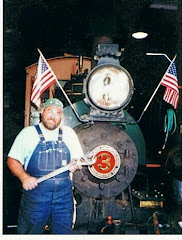Having followed the Bio-diesel craze for the last couple years I have decided it is time to make my own. With many of the Santa Cruz people I live around doing this with success, and now having the mileage on their vehicles to warrant a try, I am diving in.
So here is what I am doing. I currently have 4 sources for Waste Vegetable Oil from either restaurants or schools and even the facility I manage. I need a few more so I can get my supply up to 30 gallons per week if possible. Anyhow the oil is collected using a 50 gallon transfer tank and hand pump that I mounted on a pallet and sits in the back of my 1 ton flatbed truck.
 When I return to the shop, I pump the WVO out of the tank and into a clean 5 gallon bucket with a paint strainer to catch all the crumbs and dead french fries. I then pour the oil into my batch plant keeping track of how many gallons I put in.
When I return to the shop, I pump the WVO out of the tank and into a clean 5 gallon bucket with a paint strainer to catch all the crumbs and dead french fries. I then pour the oil into my batch plant keeping track of how many gallons I put in. The tank has a heater which I turn on to heat the oil to 130 degrees. I then circulate the oil using this old hot water recirculation pump I salvaged.
The tank has a heater which I turn on to heat the oil to 130 degrees. I then circulate the oil using this old hot water recirculation pump I salvaged.
The oil is then pumped through two household type water filters. First one is a 25 micron and the second is a 20 micron. The helps remove any other sediment that could clog a fuel filter in a vehicle.

After letting the oil go through this filtration process overnight, I then turn off the pump and heater and let the oil assume room temperature. The next day, I remove any water that has settled on the bottom of the batch. Basically I pump out the water until I see good oil being careful to measure just how much I remove in gallons. Then it is time to do that magic I do. Following a recipe from post-WWll Germany, I mix in Kerosene, Unleaded Gas, Diesel Kleen (Walmart) and Heet (Kragen). Stir for 10-15 minutes and then turn the pump on and recirculate the mix for an hour. Then the fuel is ready to transfer from the batch plant to the pumping station.

The pumping station above is built from a 55 gallon poly drum that I mounted a diesel pump I got from Northern Tool. From the pump the fuel goes to another household water type filter that is a 5 micron and then into a Goldenrod Water-block Fuel Filter. From there it goes into the nozzle and into the vehicle. As you can see in the picture below, the fuel is clear and looks just like diesel.

So I have been running this fuel which is known as B-87 (87%WVO & 13% other petrochemicals) in my John Deere 950 and it works great. The engine is quieter and just as much power as before. Since my family is always taking trips to town for this and that and eating up fuel, I decided to look for a vehicle that runs on diesel that I could get for cheap and not worry if it craps out, kind of an experimental for this homemade brew. So I found this fine looking Mercedes 300D in Watsonville at a dealership. Got it for $800.00 and its great! Runs good, looks OK, interior is nice and has a good sound system in it.

So now when the kids want to go to Taco Bell, they take the "Benz" and as they are driving down the road, all I smell is French Fries cooking! So how much does it cost me to make you ask? Well I have an investment of the processing and pumping equipment. The oil I get for free. After adding the ingredients I figure it costs me .88 cents per gallon to make. Now what I smell is MONEY!







No comments:
Post a Comment